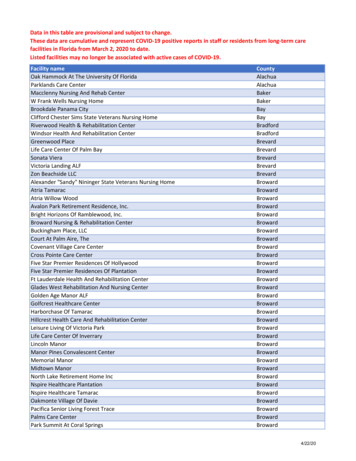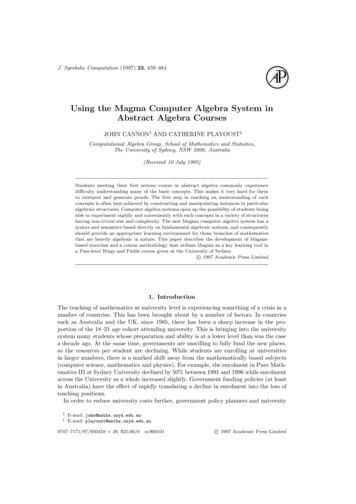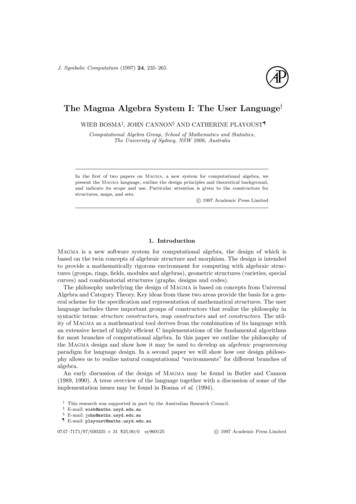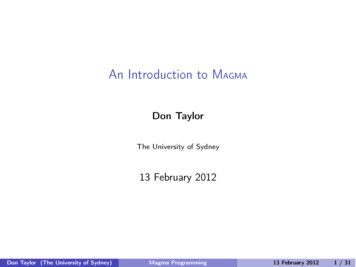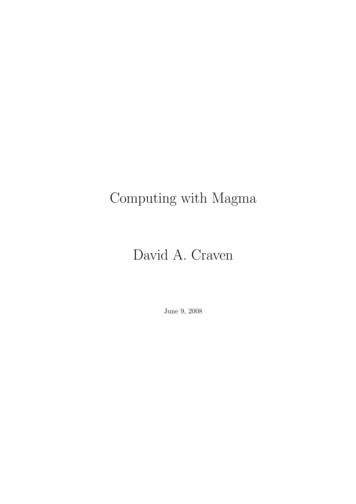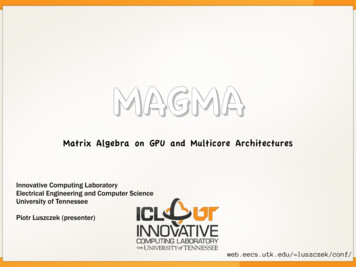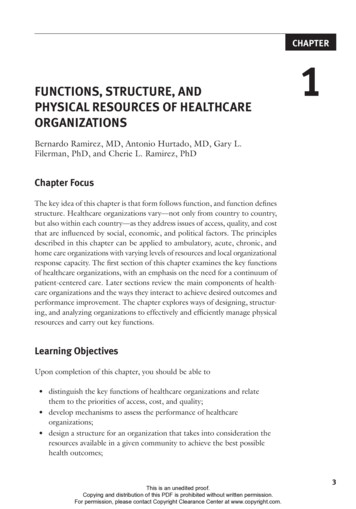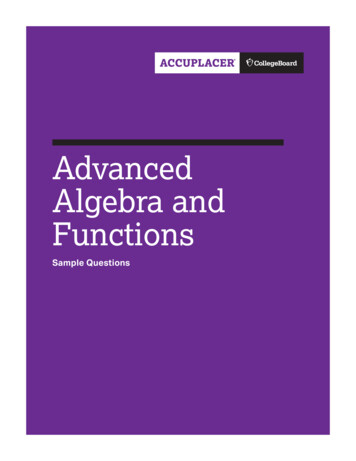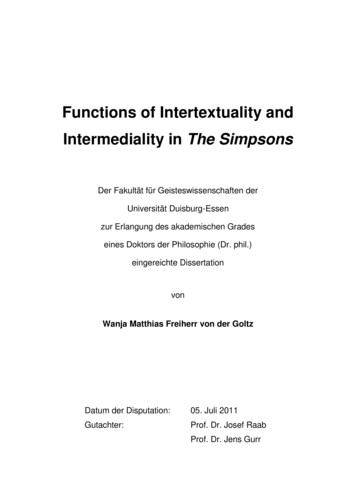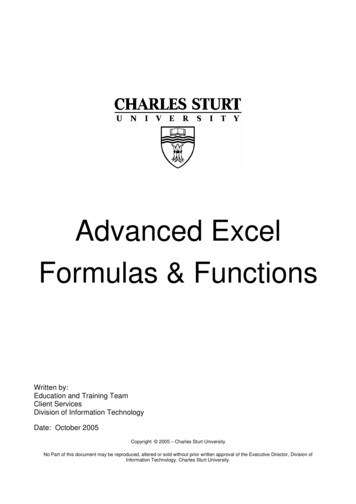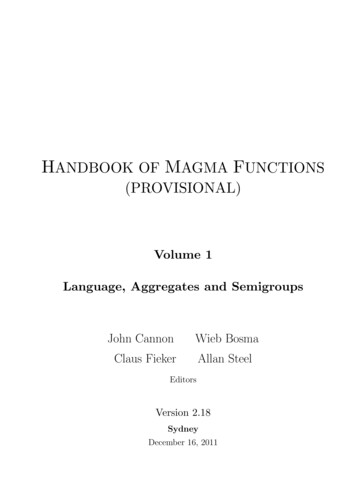
Transcription
HANDBOOK OF MAGMA FUNCTIONS(PROVISIONAL)Volume 1Language, Aggregates and SemigroupsJohn CannonWieb BosmaClaus FiekerAllan SteelEditorsVersion 2.18SydneyDecember 16, 2011
ii
M A G M ACOMPUTERALGEBRAHANDBOOK OF MAGMA FUNCTIONSEditors:John CannonWieb BosmaClaus FiekerAllan SteelHandbook Contributors:Geoff Bailey, Wieb Bosma, Gavin Brown, Nils Bruin, JohnCannon, Jon Carlson, Scott Contini, Bruce Cox, Brendan Creutz, Steve Donnelly, Tim Dokchitser, Willem deGraaf, Claus Fieker, Damien Fisher, Volker Gebhardt, SergeiHaller, Michael Harrison, Florian Hess, Derek Holt, AlKasprzyk, Markus Kirschmer, David Kohel, Axel Kohnert,Dimitri Leemans, Paulette Lieby, Graham Matthews, ScottMurray, Eamonn O’Brien, Dan Roozemond, Ben Smith,Bernd Souvignier, William Stein, Allan Steel, Damien Stehlé,Nicole Sutherland, Don Taylor, Bill Unger, Alexa van derWaall, Paul van Wamelen, Helena Verrill, John Voight, MarkWatkins, Greg WhiteProduction Editors:Wieb BosmaClaus FiekerAllan SteelHTML Production:Claus FiekerAllan SteelNicole Sutherland
PREFACEThe computer algebra system Magma is designed to provide a software environment forcomputing with the structures which arise in areas such as algebra, number theory, algebraic geometry and (algebraic) combinatorics. Magma enables users to define and tocompute with structures such as groups, rings, fields, modules, algebras, schemes, curves,graphs, designs, codes and many others. The main features of Magma include: Algebraic Design Philosophy: The design principles underpinning both the user language and system architecture are based on ideas from universal algebra and categorytheory. The language attempts to approximate as closely as possible the usual mathematical modes of thought and notation. In particular, the principal constructs in theuser language are set, (algebraic) structure and morphism. Explicit Typing: The user is required to explicitly define most of the algebraic structuresin which calculations are to take place. Each object arising in the computation is thendefined in terms of these structures. Integration: The facilities for each area are designed in a similar manner using genericconstructors wherever possible. The uniform design makes it a simple matter to program calculations that span different classes of mathematical structures or which involvethe interaction of structures. Relationships: Magma provides a mechanism that manages “relationships” betweencomplex bodies of information. For example, when substructures and quotient structures are created by the system, the natural homomorphisms that arise are alwaysstored. These are then used to support automatic coercion between parent and childstructures. Mathematical Databases: Magma has access to a large number of databases containinginformation that may be used in searches for interesting examples or which form anintegral part of certain algorithms. Examples of current databases include factorizationsof integers of the form pn 1, p a prime; modular equations; strongly regular graphs;maximal subgroups of simple groups; integral lattices; K3 surfaces; best known linearcodes and many others. Performance: The intention is that Magma provide the best possible performanceboth in terms of the algorithms used and their implementation. The design philosophypermits the kernel implementor to choose optimal data structures at the machine level.Most of the major algorithms currently installed in the Magma kernel are state-of-theart and give performance similar to, or better than, specialized programs.The theoretical basis for the design of Magma is founded on the concepts and methodologyof modern algebra. The central notion is that of an algebraic structure. Every objectcreated during the course of a computation is associated with a unique parent algebraicstructure. The type of an object is then simply its parent structure.
viPREFACEAlgebraic structures are first classified by variety: a variety being a class of structureshaving the same set of defining operators and satisfying a common set of axioms. Thus,the collection of all rings forms a variety. Within a variety, structures are partitioned intocategories. Informally, a family of algebraic structures forms a category if its members allshare a common representation. All varieties possess an abstract category of structures(the finitely presented structures). However, categories based on a concrete representationare as least as important as the abstract category in most varieties. For example, withinthe variety of algebras, the family of finitely presented algebras constitutes an abstractcategory, while the family of matrix algebras constitutes a concrete category.Magma comprises a novel user programming language based on the principles outlinedabove together with program code and databases designed to support computational research in those areas of mathematics which are algebraic in nature. The major areasrepresented in Magma V2.18 include group theory, ring theory, commutative algebra,arithmetic fields and their completions, module theory and lattice theory, finite dimensional algebras, Lie theory, representation theory, homological algebra, general schemesand curve schemes, modular forms and modular curves, finite incidence structures, linearcodes and much else.This set of volumes (known as the Handbook) constitutes the main reference work onMagma. It aims to provide a comprehensive description of the Magma language and themathematical facilities of the system, In particular, it documents every function and operator available to the user. Our aim (not yet achieved) is to list not only the functionalityof the Magma system but also to show how the tools may be used to solve problems inthe various areas that fall within the scope of the system. This is attempted through theinclusion of tutorials and sophisticated examples. Finally, starting with the edition corresponding to release V2.8, this work aims to provide some information about the algorithmsand techniques employed in performing sophisticated or time-consuming operations. It willtake some time before this goal is fully realised.We give a brief overview of the organization of the Handbook. Volume 1 contains a terse summary of the language together with a description of thecentral datatypes: sets, sequences, tuples, mappings, etc. It also describes the facilitiesfor semigroups and monoids. An index of all intrinsics appears at the end of the volume. Volume 2 deals with basic rings and linear algebra. The rings include the integers, therationals, finite fields, univariate and multivariate polynomial rings as well as real andcomplex fields. The linear algebra section covers matrices and vector spaces. Volume 3 covers global arithmetic fields. The major topics are number fields, theirorders and function fields. More specialised topics include quadratic fields , cyclotomicfields and algebraically closed fields. Volume 4 is concerned with local arithmetic fields. This covers p-adic rings and theirextension and power series rings including Laurent and Puiseux series rings,
PREFACEvii Volume 5 describes the facilities for finite groups and, in particular, discusses permutation groups, matrix groups and finite soluble groups defined by a power-conjugatepresentation. A chapter is devoted to databases of groups. Volume 6 describes the machinery provided for finitely presented groups. Includedare abelian groups, general finitely presented groups, polycyclic groups, braid groupsand automatic groups. This volume gives a description of the machinery provided forcomputing with finitely presented semigroups and monoids. Volume 7 is devoted to aspects of Lie theory and module theory. The Lie theory includesroot systems, root data, Coxeter groups, reflection groups and Lie groups. Volume 8 covers algebras and representation theory. Associative algebras includestructure-constant algebras, matrix algebras, basic algebras and quaternion algebras.Following an account of Lie algebras there is a chapter on quantum groups and anotheron universal enveloping algebras. The representation theory includes group algebras,K[G]-modules, character theory, representations of the symmetric group and representations of Lie groups. Volume 9 covers commutative algebra and algebraic geometry. The commutative algebra material includes constructive ideal theory, affine algebras and their modules, invariant rings and differential rings. In algebraic geometry the main topics are schemes,sheaves and toric varieties. Also included are chapters describing specialised machineryfor curves and surfaces. Volume 10 describes the machinery pertaining to arithmetic geometry. The main topicsinclude the arithmetic properties of low genus curves such as conics, elliptic curves andhyperelliptic curves. The volume concludes with a chapter on L-series. Volume 11 is concerned with modular forms. Volume 12 covers various aspects of geometry and combinatorial theory. The geometrysection includes finite planes, finite incidence geometry and convex polytopes. Thecombinatorial theory topics comprise enumeration, designs, Hadamard matrices, graphsand networks. Volume 13 is primarily concerned with coding theory. Linear codes over both fieldsand finite rings are considered at length. Further chapters discuss machinery for AGcodes, LDPC codes, additive codes and quantum error-correcting codes. The volumeconcludes with short chapters on pseudo-random sequences and on linear programming.Although the Handbook has been compiled with care, it is possible that the semantics ofsome facilities have not been described adequately. We regret any inconvenience that thismay cause, and we would be most grateful for any comments and suggestions for improvement. We would like to thank users for numerous helpful suggestions for improvement andfor pointing out misprints in previous versions.
viiiPREFACEThe development of Magma has only been possible through the dedication and enthusiasm of a group of very talented mathematicians and computer scientists. Since 1990,the principal members of the Magma group have included: Geoff Bailey, Mark Bofinger, Wieb Bosma, Gavin Brown, John Brownie, Herbert Brückner, Nils Bruin, SteveCollins, Scott Contini, Bruce Cox, Brendan Creutz, Steve Donnelly, Willem de Graaf,Claus Fieker, Damien Fisher, Alexandra Flynn, Volker Gebhardt, Katharina Geißler,Sergei Haller, Michael Harrison, Emanuel Herrmann, Florian Heß, Al Kasprzyk, DavidKohel, Paulette Lieby, Graham Matthews, Scott Murray, Anne O‘Kane, Catherine Playoust, Richard Rannard, Colva Roney-Dougal, Dan Roozemond, Andrew Solomon, BerndSouvignier, Ben Smith, Allan Steel, Damien Stehlé, Nicole Sutherland, Don Taylor, BillUnger, John Voight, Alexa van der Waall, Mark Watkins and Greg White.John CannonSydney, December 2011
ACKNOWLEDGEMENTSThe Magma Development TeamCurrent MembersGeoff Bailey, BSc (Hons) (Sydney), [1995-]: Main interests include elliptic curves (especially those defined over the rationals), virtual machines and computer language design.Has implemented part of the elliptic curve facilities especially the calculation of MordellWeil groups. Other main areas of contribution include combinatorics, local fields and theMagma system internals.John Cannon Ph.D. (Sydney), [1971-]: Research interests include computational methods in algebra, geometry, number theory and combinatorics; the design of mathematicalprogramming languages and the integration of databases with Computer Algebra systems.Contributions include overall concept and planning, language design, specific design formany categories, numerous algorithms (especially in group theory) and general management.Brendan Creutz, Ph.D. (Jacobs University Bremen) [2011-]: Primary research interestsare in arithmetic geometry. Main contributions focus on descent obstructions to the existence of rational points on curves and torsors under their Jacobians. Currently developinga package for cyclic covers of the projective line.Steve Donnelly, Ph.D. (Georgia) [2005-]: Research interests are in arithmetic geometry,particularly elliptic curves and modular forms. Major contributions include descent methods for elliptic curves (including over function fields) and Cassels-Tate pairings, classicalmodular forms of half-integral weight, Hilbert modular forms and fast algorithms for definite quaternion algebras. Currently working on Hilbert modular forms, and elliptic curvesover number fields.Claus Fieker, Ph.D. (TU Berlin), [2000-]: Formerly a member of the KANT project.Research interests are in constructive algebraic number theory and, especially, relativeextensions and computational class field theory. Main contributions are the developmentof explicit algorithmic class field theory in the case of both number and function fields andthe computation of Galois groups.Michael Harrison, Ph.D. (Cambridge,UK 1992), [2003-]: Research interests are in number theory, arithmetic and algebraic geometry. Implemented the p-adic methods for counting points on hyperelliptic curves and their Jacobians over finite fields: Kedlaya’s methodand the modular parameter method of Mestre. Currently working on machinery for generalsurfaces and cohomology for projective varieties.Dan Roozemond, Ph.D. (Eindhoven), [2010-]: Research focuses on the computationalaspects of Lie theory. Ported algorithms for the Weight Multisets from LiE to Magma
xACKNOWLEDGEMENTSand developed a number of algorithms for reductive Lie algebras, particularly over fieldsof small characteristic.Allan Steel, BA (Hons, University Medal) (Sydney), [1989-]: Has developed many ofthe fundamental data structures and algorithms in Magma for multiprecision integers,finite fields, matrices and modules, polynomials and Gröbner bases, aggregates, memorymanagement, environmental features, and the package system, and has also worked on theMagma language interpreter. In collaboration, he has developed the code for la
The computer algebra system Magma is designed to provide a software environment for computing with the structures which arise in areas such as algebra, number theory, al-gebraic geometry and (algebraic) combinatorics. Magma enables users to define and to compute with structures such as groups, rings, fields, modules, algebras, schemes, curves,
